I found this article most enlightening and I believe it's something the rams coaching team should look at....
http://bleacherreport.com/articles/2555624-preseason-acl-injures-can-be-drastically-reduced-heres-how?utm_source=newsletter&utm_medium=newsletter&utm_campaign=nfl
Preseason ACL Injures Can Be Drastically Reduced. Here's How
Jordy Nelson's ACL tear didn't have to happen. Neither did Kelvin Benjamin's. Or Orlando Scandrick's: A non-contact injury, just like the others. Many of the other ACL tears, hamstring pulls and soft-tissue injuries that have plagued this preseason did not have to happen.
Sure, some injuries will always, inevitably occur. But the number of non-contact, soft-tissue injuries could easily be cut in half, or even further reduced.
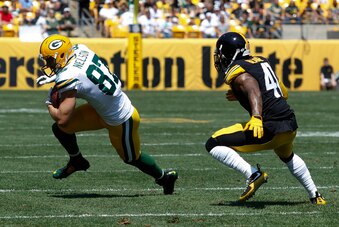
Charles LeClaire-USA TODAY Sports
Jordy Nelson
"You can reduce risk [of non-contact ACL injuries in the NFL] somewhere between 50 and 70 percent," according to Dr. Timothy Hewett, director of biomechanics and sports medicine research at the Mayo Clinic, who has researched knee injuries for over 20 years.
This drastic reduction does not involve abolishing preseason games, eliminating joint practices or boxing players in packing peanuts until the opening-day kickoff. All it takes is an open-minded approach to proven medical research, a minor shakeup of the traditional NFL practice routine and maybe a few plastic milk crates.
The Milk Carton Test
Hewett developed a way to screen athletes who were at high risk for knee injuries while conducting research at Ohio State University. The test was based on years of longitudinal studies of incoming Ohio State athletes and local high school football players. The test starts with a one-foot-high box.
"The reason we use a foot-high box is that I would go out to schools and find a plastic milk carton," Hewett said. "I'd put them out there and have a player drop off the box—not jump forward, just drop as if they're landing."
Players were instructed to leap after landing, and Hewett's researchers carefully studied the movement of the legs, thighs and hips. The modern screening test uses high-speed cameras, motion capture and 3-D imaging, but a low-tech approach can be almost as effective if you know what you are looking for.
"Even if you have a simple cellphone, just take a video of it," Hewett said. "You can see, right before landing, the position of how far apart the knees are. If those knees collapse into half or more of that distance, that player is showing what we call 'ligament dominance.'"
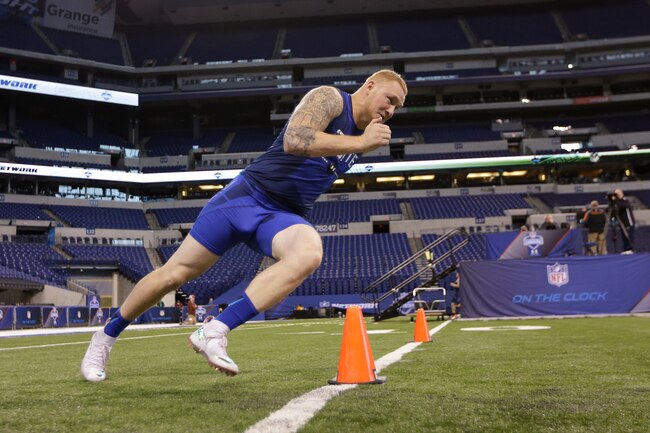
David J. Phillip/Associated Press
Maxx Williams
There's more to it than that. Hewett's explanations of ACL tears are peppered with phrases like abduction and adduction, cadaveric studies and asymmetric neuromuscular patterns. But even at its most scientific, the concept is simple. Some athletes are more likely to suffer an ACL tear than others, based on biomechanics that can be easily and affordably analyzed.
These players don't have to take a helmet to the knee to suffer an ACL tear; in fact, Hewett's research indicates that 70 percent of ACL injuries in the NFL, like many of this preseason's high-profile injuries, are not contact-related. Many outstanding athletes jump, land and plant their feet in ways that, combined with their great size and speed, create forces that will inevitably result in injuries.
High-risk players don't have to get crossed off the draft board or left off the shopping list in free agency.
"Here's the good news," Hewett said. "There are things that can be done that have been demonstrated again and again to work in randomized trials. With neuromuscular training, we can reduce those risk factors."
So NFL teams (or any other sports teams) can identify athletes with high ACL risks, alter their training regimens and lower their non-contact-injury risks by more than half.
But here's the bad news: Not many teams are doing it.
"The data is there, but the implementation and compliance is very weak," Hewett said.
The Crystal Ball
Gary McCoy watched from the sideline as one of the many NFL teams he consults for opened its training camp in late July. On the first day, the coach brought players just back from a few weeks of inactivity straight onto the practice field and, after some basic stretching and drills, ran them through nearly 100 scripted plays. The players planted, cut, jumped and ran at full speed in the summer heat, over and over again.
It was an old-school start-of-camp baptism in the summer heat. It was also a nightmare for hamstrings, tendons and those ligaments in the knee that can cause Super Bowl chances to nosedive with a single snap.
McCoy, the sports performance director for Catapult, a company that makes wearable performance monitors for athletes, watched practice in dismay.
"If that's the way they are going to run this camp, going zero to 100 miles per hour, all that you can manage is the recovery side of it," McCoy told the team's strength and conditioning coach, who was also unhappy with the intensity of the practice.
Catapult's monitors and other devices on the sports-performance market can take Hewett's fall-off-the-crate test beyond the next level. Wearable technology can gauge and quantify the player fatigue that leads to bad biomechanics and injuries—a wide receiver suddenly taking many more strides to achieve the same speed, for instance. It can measure the loads on knees and joints, forces that lead to the abduction and adduction that lead to ACL tears.
Wearable technology can essentially be used as an early-alert system for soft-tissue injury risk. Fifteen NFL teams are on-the-record Catapult clients. Dozens of NCAA teams use the technology as well.
But hooking monitors to players is useless if coaches do nothing—or the wrong things—with the data.
"It's like providing the painter with paint," McCoy said. "It's up to the artists what they render."
Sure enough, the team that ramped its players up too quickly to full-speed cutting and planting has been crippled by preseason injuries: hamstring pulls, meniscus tears and other non-contact ailments.
"We could see it like a crystal ball," McCoy said.
Meanwhile, another of McCoy's clients reported zero soft-tissue injuries as of last week. McCoy surveyed that team's practice methods and found a better marriage of science and application: individualized programs, increased monitoring and no zero-to-100 acceleration on those first days of practice.
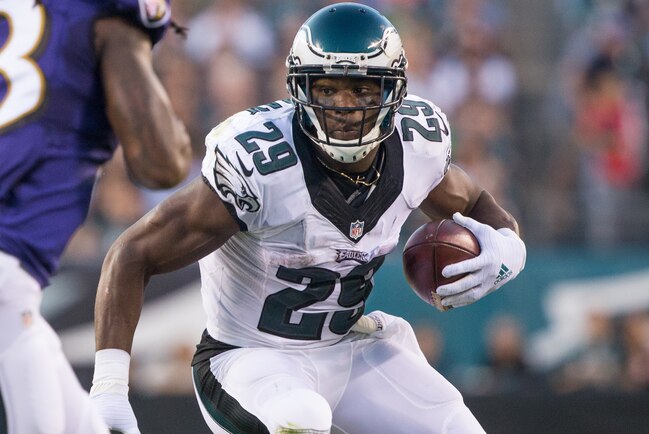
Bill Streicher-USA TODAY Sports
DeMarco Murray
Different coaches and organizations place different levels of emphasis and faith in "sports science," an overstuffed umbrella term for just about any training, performance or rehabilitation procedure that comes from a recent medical journal rather than inherited Vince Lombardi wisdom.
On one end of the spectrum, Chip Kelly patiently explains to reporters that DeMarco Murray is required to skip drills or practices if he's too dehydrated or the load results on his knees are perilously high. On the other side, well, some coaches don't appear to notice if a quarterback is limping around on national television.
Just about every organization, though, is using an outdated training model, one that trades a marked increase in injury risk for a few extra practice reps. And the 2011 collective bargaining agreement, full of limits and restrictions designed to keep players healthy, is almost certainly making matters worse.
The Shortened Ramp
Hewett has tracked ACL data since before the 2011 lockout and the current collective bargaining agreement. When injuries rocketed up immediately after the lockout, he hypothesized it was just a matter of athletes rushing onto the field after months of relative inactivity. But the numbers never really came down. And ACL tears do tend to cluster around training camp and the preseason.
"That points to a lack of preparation," Hewett said.
McCoy agrees. "If you talk to any strength coach in the NFL, they'll tell you, 'We don't have the time to get these guys in shape by the time the demands of that first practice session kicks in.'"
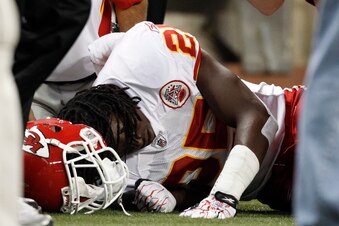
Rick Osentoski/Associated Press
Jamaal Charles
The 2011 collective bargaining agreement added a dizzying array of restrictions on offseason training. The nine-week OTA period is broken into three phases. Strength and conditioning, with no on-field work, is limited to the first three-week phase. After that, coaches can schedule 90-minute on-field practices, while players are only required to be at the team facility for four hours; factor in everything from meetings to suiting up, and conditioning gets the short shrift.
The CBA rules were designed to severely limit full-contact practices and keep coaches from requiring 60-hour work weeks in May, both worthy goals from a player-safety standpoint. But the rules squeezed out much of the offseason conditioning work. That's a problem, because the exercises and drills that can prevent ACL tears and soft-tissue injuries take additional time and must be reinforced over a series of weeks.
"These guys need to be doing those drills two months before they get on that field," Hewett said.
Players then take a month off before returning to training camp, where on-field practice time dwarfs conditioning time and, as we have seen, coaches are too quick to return players to immediate football-like activities.
"There's a much shorter ramp in terms of available time for player training, and we see things like excessive player load scores," McCoy said. "Those increased player load scores are adding up to a lot of non-contact soft-tissue injuries."
The CBA won't be reopened for many years. At the next round of negotiations, players should consider giving coaches back a few hours of offseason work in exchange for stipulations that the time is devoted to injury-prevention conditioning.
In the meantime, coaches don't have to run 90-minute on-field practices during OTAs, and they certainly don't have to start training camp with dozens of scripted plays. That time could be devoted to drills that are proven to reduce ACL and soft-tissue injury risks—or at least ramping players up to full speed more gradually.
Loading the Dice
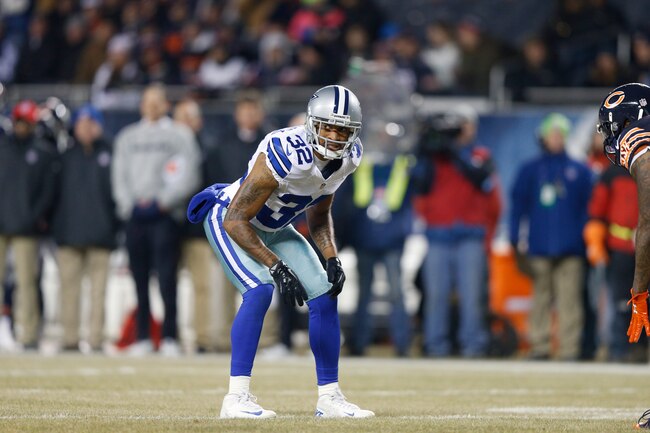
Joe Robbins/Getty Images
Orlando Scandrick
So teams can start by replacing many minicamp and training camp drills with smarter conditioning work. What else can be done to eliminate non-contact ACL tears and similar injuries?
Individualize Workout Routines: One-size-fits-all fitness regimens do not work, but NFL teams vary widely in their individualization policies.
"Since every athlete has a different baseline level of risk, based on their individual anatomy, injury history, tissue strength/laxity, neuromotor pattern history and so on, it therefore becomes critical to know more precisely what each athlete's individual baseline is and to strategically reduce the baseline risk where you can," said Mike Hahn, director of the Bowerman Sports Science Clinic.
Hewett's research—an athlete who has already suffered an ACL tear is 14 to 15 times more likely to suffer another tear—can identify at-risk athletes. Wearable monitors, dehydration tests and other techniques can be used to identify players whose risk factors are suddenly changing due to fatigue and other influences, allowing coaches to adjust workloads in real time.
"It's kind of like NASCAR," McCoy said. "It's like having the crew chief in the driver's ear, saying, 'Hey, pull back. We think the tires are worn, or you are lower on gas now and we want to sustain for the final laps.' They can dashboard these athletes."
Symmetry and Balance Training: Most humans are asymmetrical from a neuromuscular standpoint: stronger on our dominant side. Great athletes are no exception, and there are other asymmetries besides right- or left-handedness, including "quadriceps dominance," which puts a strain on knee ligaments. Asymmetry leads to strain the weaker muscles, joints and soft tissue, which leads to non-contact injuries.
Hewett outlined a whole series of exercises designed to get players to use the balls of their feet as "rockers" (flat-footed landings cause many ACL tears), activate different muscle groups and alleviate any asymmetries. Many athletic trainers are familiar with these exercises, but again: A) They lack time to implement them, and B) The exercises must be individualized, meaning one set of players may be out on the field while the at-risk group is doing balance drills.
Avoid Artificial Turf Whenever Possible: Even the highest-quality artificial turf increases stress loads on the knee, according to McCoy. Artificial turf has a higher coefficient of friction than grass, which means the foot sticks to it, and all of the player's torque has to go somewhere when he plants and turns and the ground beneath him doesn't let his foot budge. That somewhere is the knee.
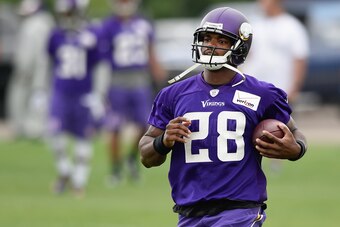
Hannah Foslien/Getty Images
Adrian Peterson
"The only way a coaching staff can manage that is cut back time or cut back repetitions on artificial surfaces," McCoy said.
Of course, many NFL stadiums use artificial turf (some, in colder climates or in domes, have no choice), and a few others have notoriously shoddy natural playing surfaces. If the home field is a potential injury risk and nothing can be done about it, the best bet may be to keep players off the home field until it absolutely matters.
Beware of Preseason Games: Preseason games aren't going anywhere, folks. And experts generally stop short of calls for the abolition of preseason games. Hewett acknowledges there is a risk involved in waiting until opening day to introduce full-speed, full-contact football. There's a balance between minimizing risk and maximizing preparation.
McCoy agrees. "You want your starters to get their repetitions in, and you want them in game environments," he said. "That's the optimal practice environment they can be in."
But Hahn spells out the issue simply: "Every time the player is in a 'real-world' drill, scrimmage, preseason game, regular-season game and so on, they are going to experience a baseline level of risk. Increasing the number of reps therefore increases the overall risk/probability of sustaining the injury, using basic probability."
Every preseason snap is a roll of the dice. Kelvin Benjamin probably needed more die rolls to achieve his potential than Jordy Nelson. DeMarco Murray, Adrian Peterson and Marshawn Lynch should barely roll the dice at all; their coaches (and even casual fans) know it. But rookies, backups and journeymen need to play in preseason games, scrimmages and joint practices so they can refine their skills and advance their careers.
That's why teams need to load the dice: Identify and retrain high-risk players, monitor and hold back the fatigued players, take the field conditions into account and, most of all, take the necessary steps in April to avoid bad news in August.
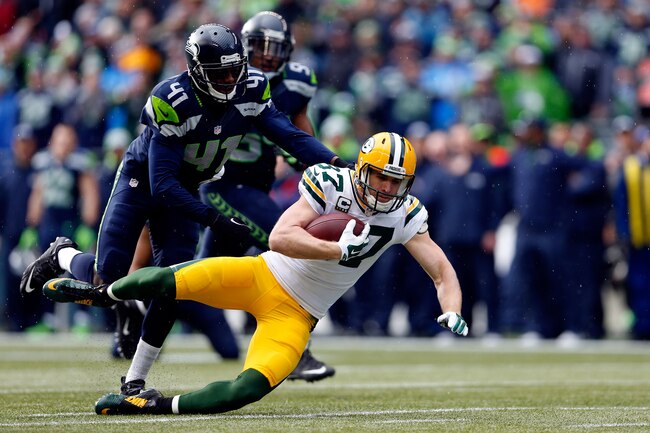
Christian Petersen/Getty Images
Jordy Nelson
NFL organizations, coaches and even the players union must be open to accepting the research and tinkering under the hood of offseason and preseason routines if they hope to reduce injuries that cost tens of millions of dollars per year, impact the standings and ruin careers. The NBA and FIFA have been quicker to adopt injury-averse practice habits and invest additional research in preventing soft-tissue injury than the NFL, according to Hewett.
"Most people think, 'Well, football is a contact sport. You can't prevent an ACL tear in a contact sport.' Yes you can, because 70 percent of them are non-contact."
If teams can cut ACL tears in half by converting some on-field practices to training sessions, running a few tests and customizing a few workout regimens, it makes good business sense and football sense to make the changes.
"It's worth it," Hewett said, "especially when dealing with players with that kind of value."
http://bleacherreport.com/articles/2555624-preseason-acl-injures-can-be-drastically-reduced-heres-how?utm_source=newsletter&utm_medium=newsletter&utm_campaign=nfl
Preseason ACL Injures Can Be Drastically Reduced. Here's How
Jordy Nelson's ACL tear didn't have to happen. Neither did Kelvin Benjamin's. Or Orlando Scandrick's: A non-contact injury, just like the others. Many of the other ACL tears, hamstring pulls and soft-tissue injuries that have plagued this preseason did not have to happen.
Sure, some injuries will always, inevitably occur. But the number of non-contact, soft-tissue injuries could easily be cut in half, or even further reduced.

Charles LeClaire-USA TODAY Sports
Jordy Nelson
"You can reduce risk [of non-contact ACL injuries in the NFL] somewhere between 50 and 70 percent," according to Dr. Timothy Hewett, director of biomechanics and sports medicine research at the Mayo Clinic, who has researched knee injuries for over 20 years.
This drastic reduction does not involve abolishing preseason games, eliminating joint practices or boxing players in packing peanuts until the opening-day kickoff. All it takes is an open-minded approach to proven medical research, a minor shakeup of the traditional NFL practice routine and maybe a few plastic milk crates.
The Milk Carton Test
Hewett developed a way to screen athletes who were at high risk for knee injuries while conducting research at Ohio State University. The test was based on years of longitudinal studies of incoming Ohio State athletes and local high school football players. The test starts with a one-foot-high box.
"The reason we use a foot-high box is that I would go out to schools and find a plastic milk carton," Hewett said. "I'd put them out there and have a player drop off the box—not jump forward, just drop as if they're landing."
Players were instructed to leap after landing, and Hewett's researchers carefully studied the movement of the legs, thighs and hips. The modern screening test uses high-speed cameras, motion capture and 3-D imaging, but a low-tech approach can be almost as effective if you know what you are looking for.
"Even if you have a simple cellphone, just take a video of it," Hewett said. "You can see, right before landing, the position of how far apart the knees are. If those knees collapse into half or more of that distance, that player is showing what we call 'ligament dominance.'"

David J. Phillip/Associated Press
Maxx Williams
There's more to it than that. Hewett's explanations of ACL tears are peppered with phrases like abduction and adduction, cadaveric studies and asymmetric neuromuscular patterns. But even at its most scientific, the concept is simple. Some athletes are more likely to suffer an ACL tear than others, based on biomechanics that can be easily and affordably analyzed.
These players don't have to take a helmet to the knee to suffer an ACL tear; in fact, Hewett's research indicates that 70 percent of ACL injuries in the NFL, like many of this preseason's high-profile injuries, are not contact-related. Many outstanding athletes jump, land and plant their feet in ways that, combined with their great size and speed, create forces that will inevitably result in injuries.
High-risk players don't have to get crossed off the draft board or left off the shopping list in free agency.
"Here's the good news," Hewett said. "There are things that can be done that have been demonstrated again and again to work in randomized trials. With neuromuscular training, we can reduce those risk factors."
So NFL teams (or any other sports teams) can identify athletes with high ACL risks, alter their training regimens and lower their non-contact-injury risks by more than half.
But here's the bad news: Not many teams are doing it.
"The data is there, but the implementation and compliance is very weak," Hewett said.
The Crystal Ball
Gary McCoy watched from the sideline as one of the many NFL teams he consults for opened its training camp in late July. On the first day, the coach brought players just back from a few weeks of inactivity straight onto the practice field and, after some basic stretching and drills, ran them through nearly 100 scripted plays. The players planted, cut, jumped and ran at full speed in the summer heat, over and over again.
It was an old-school start-of-camp baptism in the summer heat. It was also a nightmare for hamstrings, tendons and those ligaments in the knee that can cause Super Bowl chances to nosedive with a single snap.
McCoy, the sports performance director for Catapult, a company that makes wearable performance monitors for athletes, watched practice in dismay.
"If that's the way they are going to run this camp, going zero to 100 miles per hour, all that you can manage is the recovery side of it," McCoy told the team's strength and conditioning coach, who was also unhappy with the intensity of the practice.
Catapult's monitors and other devices on the sports-performance market can take Hewett's fall-off-the-crate test beyond the next level. Wearable technology can gauge and quantify the player fatigue that leads to bad biomechanics and injuries—a wide receiver suddenly taking many more strides to achieve the same speed, for instance. It can measure the loads on knees and joints, forces that lead to the abduction and adduction that lead to ACL tears.
Wearable technology can essentially be used as an early-alert system for soft-tissue injury risk. Fifteen NFL teams are on-the-record Catapult clients. Dozens of NCAA teams use the technology as well.
But hooking monitors to players is useless if coaches do nothing—or the wrong things—with the data.
"It's like providing the painter with paint," McCoy said. "It's up to the artists what they render."
Sure enough, the team that ramped its players up too quickly to full-speed cutting and planting has been crippled by preseason injuries: hamstring pulls, meniscus tears and other non-contact ailments.
"We could see it like a crystal ball," McCoy said.
Meanwhile, another of McCoy's clients reported zero soft-tissue injuries as of last week. McCoy surveyed that team's practice methods and found a better marriage of science and application: individualized programs, increased monitoring and no zero-to-100 acceleration on those first days of practice.

Bill Streicher-USA TODAY Sports
DeMarco Murray
Different coaches and organizations place different levels of emphasis and faith in "sports science," an overstuffed umbrella term for just about any training, performance or rehabilitation procedure that comes from a recent medical journal rather than inherited Vince Lombardi wisdom.
On one end of the spectrum, Chip Kelly patiently explains to reporters that DeMarco Murray is required to skip drills or practices if he's too dehydrated or the load results on his knees are perilously high. On the other side, well, some coaches don't appear to notice if a quarterback is limping around on national television.
Just about every organization, though, is using an outdated training model, one that trades a marked increase in injury risk for a few extra practice reps. And the 2011 collective bargaining agreement, full of limits and restrictions designed to keep players healthy, is almost certainly making matters worse.
The Shortened Ramp
Hewett has tracked ACL data since before the 2011 lockout and the current collective bargaining agreement. When injuries rocketed up immediately after the lockout, he hypothesized it was just a matter of athletes rushing onto the field after months of relative inactivity. But the numbers never really came down. And ACL tears do tend to cluster around training camp and the preseason.
"That points to a lack of preparation," Hewett said.
McCoy agrees. "If you talk to any strength coach in the NFL, they'll tell you, 'We don't have the time to get these guys in shape by the time the demands of that first practice session kicks in.'"

Rick Osentoski/Associated Press
Jamaal Charles
The 2011 collective bargaining agreement added a dizzying array of restrictions on offseason training. The nine-week OTA period is broken into three phases. Strength and conditioning, with no on-field work, is limited to the first three-week phase. After that, coaches can schedule 90-minute on-field practices, while players are only required to be at the team facility for four hours; factor in everything from meetings to suiting up, and conditioning gets the short shrift.
The CBA rules were designed to severely limit full-contact practices and keep coaches from requiring 60-hour work weeks in May, both worthy goals from a player-safety standpoint. But the rules squeezed out much of the offseason conditioning work. That's a problem, because the exercises and drills that can prevent ACL tears and soft-tissue injuries take additional time and must be reinforced over a series of weeks.
"These guys need to be doing those drills two months before they get on that field," Hewett said.
Players then take a month off before returning to training camp, where on-field practice time dwarfs conditioning time and, as we have seen, coaches are too quick to return players to immediate football-like activities.
"There's a much shorter ramp in terms of available time for player training, and we see things like excessive player load scores," McCoy said. "Those increased player load scores are adding up to a lot of non-contact soft-tissue injuries."
The CBA won't be reopened for many years. At the next round of negotiations, players should consider giving coaches back a few hours of offseason work in exchange for stipulations that the time is devoted to injury-prevention conditioning.
In the meantime, coaches don't have to run 90-minute on-field practices during OTAs, and they certainly don't have to start training camp with dozens of scripted plays. That time could be devoted to drills that are proven to reduce ACL and soft-tissue injury risks—or at least ramping players up to full speed more gradually.
Loading the Dice

Joe Robbins/Getty Images
Orlando Scandrick
So teams can start by replacing many minicamp and training camp drills with smarter conditioning work. What else can be done to eliminate non-contact ACL tears and similar injuries?
Individualize Workout Routines: One-size-fits-all fitness regimens do not work, but NFL teams vary widely in their individualization policies.
"Since every athlete has a different baseline level of risk, based on their individual anatomy, injury history, tissue strength/laxity, neuromotor pattern history and so on, it therefore becomes critical to know more precisely what each athlete's individual baseline is and to strategically reduce the baseline risk where you can," said Mike Hahn, director of the Bowerman Sports Science Clinic.
Hewett's research—an athlete who has already suffered an ACL tear is 14 to 15 times more likely to suffer another tear—can identify at-risk athletes. Wearable monitors, dehydration tests and other techniques can be used to identify players whose risk factors are suddenly changing due to fatigue and other influences, allowing coaches to adjust workloads in real time.
"It's kind of like NASCAR," McCoy said. "It's like having the crew chief in the driver's ear, saying, 'Hey, pull back. We think the tires are worn, or you are lower on gas now and we want to sustain for the final laps.' They can dashboard these athletes."
Symmetry and Balance Training: Most humans are asymmetrical from a neuromuscular standpoint: stronger on our dominant side. Great athletes are no exception, and there are other asymmetries besides right- or left-handedness, including "quadriceps dominance," which puts a strain on knee ligaments. Asymmetry leads to strain the weaker muscles, joints and soft tissue, which leads to non-contact injuries.
Hewett outlined a whole series of exercises designed to get players to use the balls of their feet as "rockers" (flat-footed landings cause many ACL tears), activate different muscle groups and alleviate any asymmetries. Many athletic trainers are familiar with these exercises, but again: A) They lack time to implement them, and B) The exercises must be individualized, meaning one set of players may be out on the field while the at-risk group is doing balance drills.
Avoid Artificial Turf Whenever Possible: Even the highest-quality artificial turf increases stress loads on the knee, according to McCoy. Artificial turf has a higher coefficient of friction than grass, which means the foot sticks to it, and all of the player's torque has to go somewhere when he plants and turns and the ground beneath him doesn't let his foot budge. That somewhere is the knee.

Hannah Foslien/Getty Images
Adrian Peterson
"The only way a coaching staff can manage that is cut back time or cut back repetitions on artificial surfaces," McCoy said.
Of course, many NFL stadiums use artificial turf (some, in colder climates or in domes, have no choice), and a few others have notoriously shoddy natural playing surfaces. If the home field is a potential injury risk and nothing can be done about it, the best bet may be to keep players off the home field until it absolutely matters.
Beware of Preseason Games: Preseason games aren't going anywhere, folks. And experts generally stop short of calls for the abolition of preseason games. Hewett acknowledges there is a risk involved in waiting until opening day to introduce full-speed, full-contact football. There's a balance between minimizing risk and maximizing preparation.
McCoy agrees. "You want your starters to get their repetitions in, and you want them in game environments," he said. "That's the optimal practice environment they can be in."
But Hahn spells out the issue simply: "Every time the player is in a 'real-world' drill, scrimmage, preseason game, regular-season game and so on, they are going to experience a baseline level of risk. Increasing the number of reps therefore increases the overall risk/probability of sustaining the injury, using basic probability."
Every preseason snap is a roll of the dice. Kelvin Benjamin probably needed more die rolls to achieve his potential than Jordy Nelson. DeMarco Murray, Adrian Peterson and Marshawn Lynch should barely roll the dice at all; their coaches (and even casual fans) know it. But rookies, backups and journeymen need to play in preseason games, scrimmages and joint practices so they can refine their skills and advance their careers.
That's why teams need to load the dice: Identify and retrain high-risk players, monitor and hold back the fatigued players, take the field conditions into account and, most of all, take the necessary steps in April to avoid bad news in August.

Christian Petersen/Getty Images
Jordy Nelson
NFL organizations, coaches and even the players union must be open to accepting the research and tinkering under the hood of offseason and preseason routines if they hope to reduce injuries that cost tens of millions of dollars per year, impact the standings and ruin careers. The NBA and FIFA have been quicker to adopt injury-averse practice habits and invest additional research in preventing soft-tissue injury than the NFL, according to Hewett.
"Most people think, 'Well, football is a contact sport. You can't prevent an ACL tear in a contact sport.' Yes you can, because 70 percent of them are non-contact."
If teams can cut ACL tears in half by converting some on-field practices to training sessions, running a few tests and customizing a few workout regimens, it makes good business sense and football sense to make the changes.
"It's worth it," Hewett said, "especially when dealing with players with that kind of value."
